Menu
Physics Lesson 3.12.2 - The Physics of Projectile
Please provide a rating, it takes seconds and helps us to keep this resource free for all to use
Welcome to our Physics lesson on The Physics of Projectile, this is the second lesson of our suite of physics lessons covering the topic of Motion in Two Dimensions. Projectile Motion, you can find links to the other lessons within this tutorial and access additional physics learning resources below this lesson.
The Physics of Projectile
As stated in the Physics tutorial "Vectors and Scalars", when we have a situation that involves at least two directions, we split the vector quantities involved in components. In this case, the initial velocity v⃗0 is a vector quantity. Therefore, it is written in components where v0x represents its horizontal component and v0y the vertical one. This method of splitting the initial velocity into components is also used for another major reason. In absence of air resistance, the only acceleration acting on a projectile is the gravitational acceleration g⃗. We know that it is a vertical (downward) acceleration. Therefore, the horizontal part of the motion does not contain any acceleration (it is a uniform motion). Hence, it is necessary to study the horizontal and the vertical components of projectile separately because the horizontal component represents a uniform motion and the vertical component a uniformly decelerated motion when moving up and a uniformly accelerated motion when falling down.
If we denote the horizontal direction by x and the vertical one by y, we have for the initial velocity v⃗0:
v0y = |v⃗0| × sin θ
If the total time of flight from the throwing position (if it is on the ground) until it falls again on the ground is ttot, we obtain for the horizontal displacement 0x∆x⃗:
= v0 × cos θ × ttot
Look at the figure:
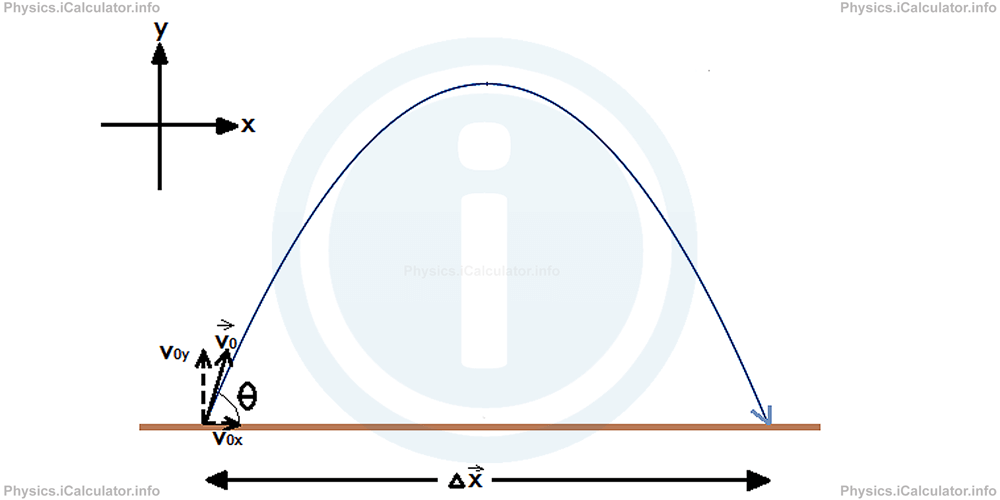
On the other hand, since the vertical part of motion is a motion with constant acceleration g⃗, we can use the four known kinematic equations to find any missing quantity required. Thus, we have
Equation 1
vy = v0y + g × tvy = v0 × sin θ + g × t
Or
Equation 2
∆y = (vy + v0y) × t/2∆y = (vy + v0 × sin θ) × t/2
Or
Equation 3
v2y - v20y = 2 × g × ∆yv2y - (v0 × sin θ )2 = 2 × g × ∆y
Or
Equation 4
∆y = v0y × t + g × t2/2∆y = v0 × sin θ × t + g × t2/2
Remarks!
∆y here represents the change in the vertical position. It is equal to ∆y = y-y0 where y0 is the initial vertical position and y is the vertical position at the instant t. We often refer to ∆y as the height h (look at the Physics tutorial "The Meaning of Acceleration. Constant and Non-Constant Acceleration. Gravitational Acceleration."
We substitute the components v0x and v0y of the initial velocity by v0 × cos θ and v0 × sin θ respectively but we cannot assign a known angle to the velocity v⃗ at any instant t because the angle changes at every instant. Therefore, we simply write vy for the vertical component of the velocity vector v⃗ (the horizontal component vx is known; it is vx = v0x = |v⃗0 | × cos θ during the entire motion as the horizontal component of a projectile is a uniform motion)
When the object reaches its highest position (at ∆ymax or hmax), it stops rising up and prepares to fall down. In that instant it is moving only horizontally as its vertical component of the velocity vy is zero. Thus, if we denote the highest point of a projectile trajectory by A, we have vyA = 0 and vxA = |v⃗A | = v0 × cos θ.
The sign of the gravitational acceleration is taken the same as it was at the beginning of motion. Thus, if the object was thrown from the ground, the sign of g is taken as negative during the entire motion, despite the fact that it accelerates in the second part of the trajectory, i.e. when falling down.
The equation of motion for the vertical part of a projectile is the fourth (the last) equation listed above. Thus, we have
y - y0 = v0 × sin θ × t + g × t2/2
Or
Therefore, the vertical position y as a function of time t is
It allows us to determine the vertical position of an object at every instant t when the initial parameters (the initial vertical coordinate y0 and the initial velocity v0) are known.
The figure below includes all the abovementioned details:
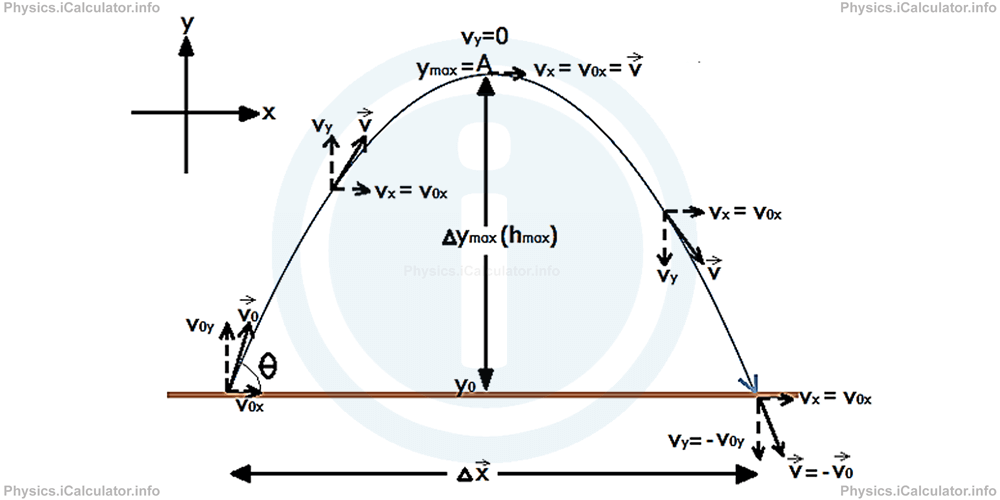
If we are interested to find the direction of the velocity vector at any given instant, we can use the concept of the tangent of the angle formed by the velocity vector and the horizontal direction. Hence, if we denote this angle by α (remember, it is different from the initial angle θ), we can write:
A small portion of the trajectory is shown in the figure below to illustrate this point:
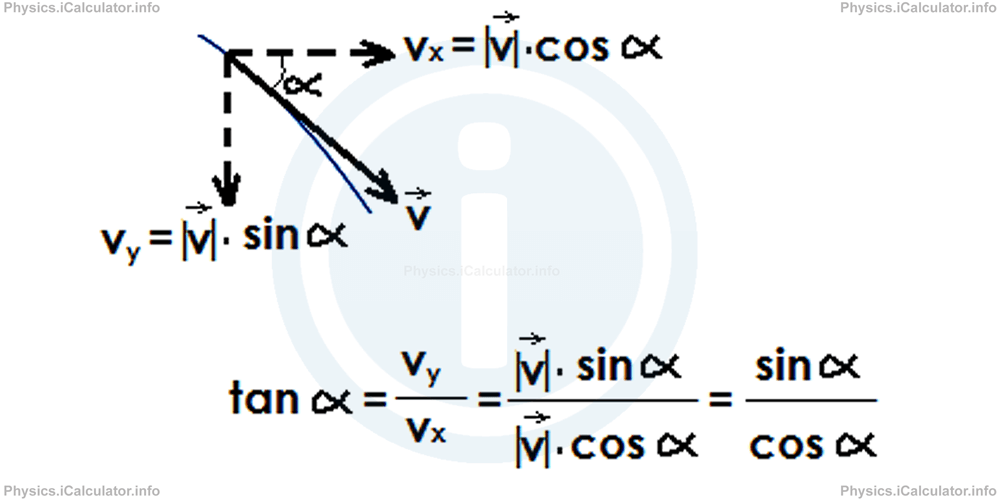
If the final vertical position of the object is the same as the initial one, there is a symmetry in the trajectory where the vertical line starting from the highest position can be considered as the line of symmetry of parabola. In this case, as discussed in the Physics tutorial "The Meaning of Acceleration. Constant and Non-Constant Acceleration. Gravitational Acceleration," the relationship between the rising time tup, the falling time tdown and the total time of flight ttotal is
The object is in two different instants at the same vertical position (height) during a projectile motion: one when it is rising up and the other when it is falling down. Unlike in the pure vertical motion, the object is in different horizontal positions in these two instants, so we have two distinct points M and N in the space in which the object is at the same height. Their coordinates are M(xM, yM) and N(xN, yN) respectively, where yM = yN. Look at the figure:
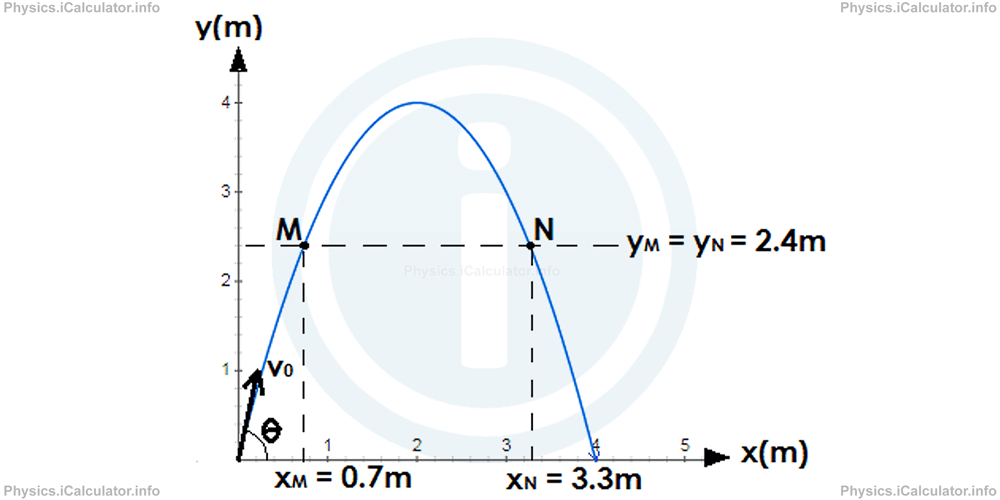
(The values obtained for the horizontal coordinates are rounded to 1 decimal place)
Let's consider at an example using the clues of the trajectory shown in the above figure.
Example 1
An object is moving according to a ballistic trajectory as shown in the figure.
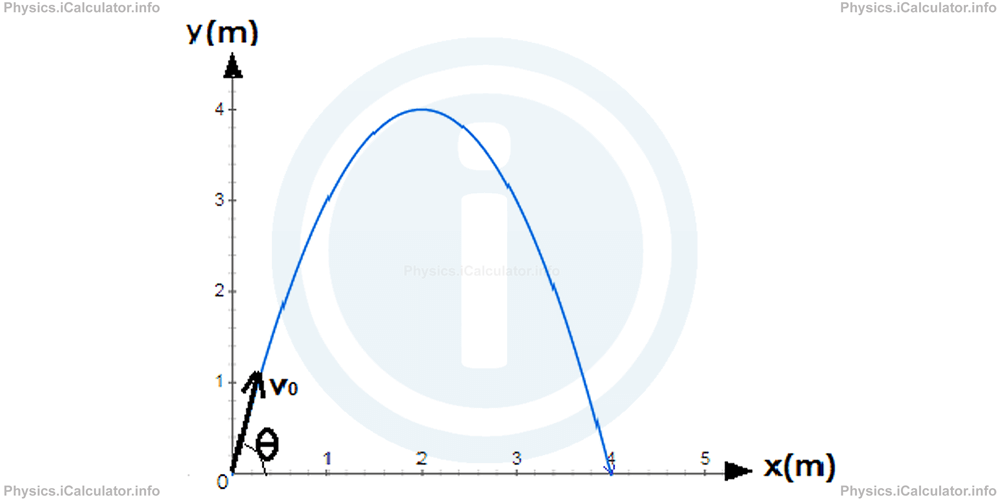
Calculate:
- The total time of flight
- The magnitude of the initial velocity
- The angle θ formed by the initial velocity vector and the horizontal direction
- The coordinates of the object at t = 0.3 s
- The instant(s) in which the object is at y = 3m
Solution 1
We can obtain some useful information from the figure. Thus, we see that the initial position of the object is at (0, 0). This means x0 = 0 and y0 = 0.
Also, it is obvious the object reaches its maximum position at yA = ymax = 4m. The corresponding horizontal coordinate is xA = 2m.
Yet, the maximum horizontal displacement is Δxmax = 4m as the object falls on the ground at that horizontal position.
Before starting with the solution, let's complete the figure with the data obtained above. (For simplicity we take the magnitude of gravitational acceleration equal to 10 m/s2.)
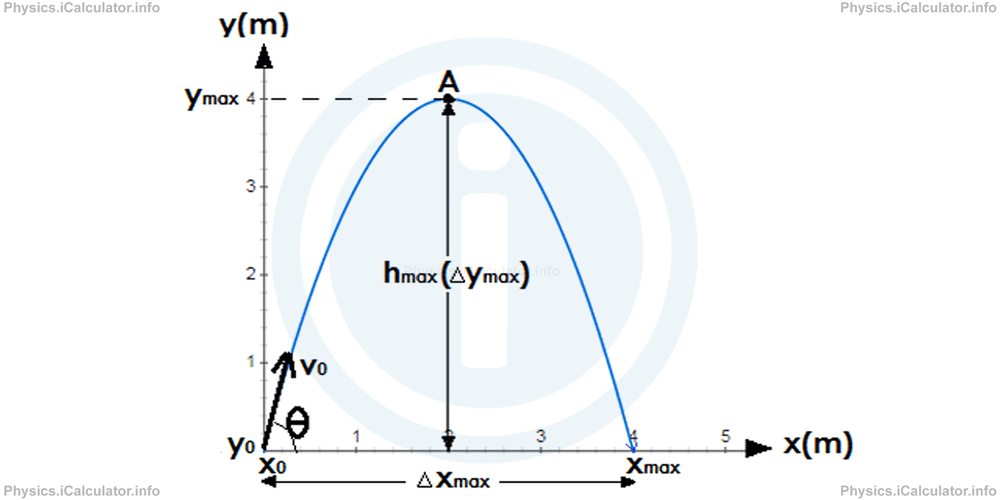
We use the info obtained for the point A to calculate the total time of flight ttot. We have:
Substituting the values, we obtain
-v20y = -80
v0y = √80m/s ≈ 8.94 m/s
Now, we can calculate the rising time tup. We have:
Substituting the values (and giving that vyA = 0), we obtain
8 = √80 × tup
tup = 8/√80= √8 × √8/√8 × √10= √8/10 = 0.89 s
Therefore, by symmetry it is obvious the total time of flight is
We need to know the horizontal component of the initial velocity v0x in order to calculate its magnitude later. We have
Substituting the known values, we obtain
v0x = 4 m/1.78 s= 2.25 m/s
Therefore, applying the known equation
we obtain for the magnitude of the initial velocity:
= √80 + 6.25
= √86.25
= 9.29 m/s
The initial angle θ is calculated using the concept of tangent of the angle θ formed by the initial velocity vector and the horizontal direction. We have
Hence,
At t = 0.3, we have
and
Substituting the known values, we obtain
= 0.675m
and
= 2.682m - 0.450m
= 2.232m
Hence, at t = 0.3s the object is at (0.675m, 2.232m). This means it is 0.675 m on the right and 2.232 m above the starting point.
As stated earlier, the object is in two instants at the same height during a projectile. Therefore, we must use the quadratic equation of motion
to calculate the required instants t. Thus, substituting the values, we obtain
-5 × t2 + 8.94 × t - 3 = 0
Dividing both sides by (-5), we obtain
Using any of the methods for solving quadratic equations, we obtain
Now, let's see what happens if an object thrown at an angle θ to the horizontal direction does not end its motion at the same level (height) but above or below the starting point. To illustrate this point we have used the numerical example below:
Example 2
A ball is kicked at 15 m/s from the terrace of a 12 m high building. The angle of the initial velocity with the horizon is 370. Ignore the air resistance and take the magnitude of g⃗ equal to 10 m/s2. Also, take cos 370 = 0.8 and sin 370 = 0.6.
Calculate:
- The maximum height (from the ground) the object can reach.
- What is the total time of flight?
- How many metres away from the building is the ball when it touches the ground?
- What is the ball's velocity just before touching the ground?
Solution 2
The figure below helps creating a clearer idea about the motion described in the problem.
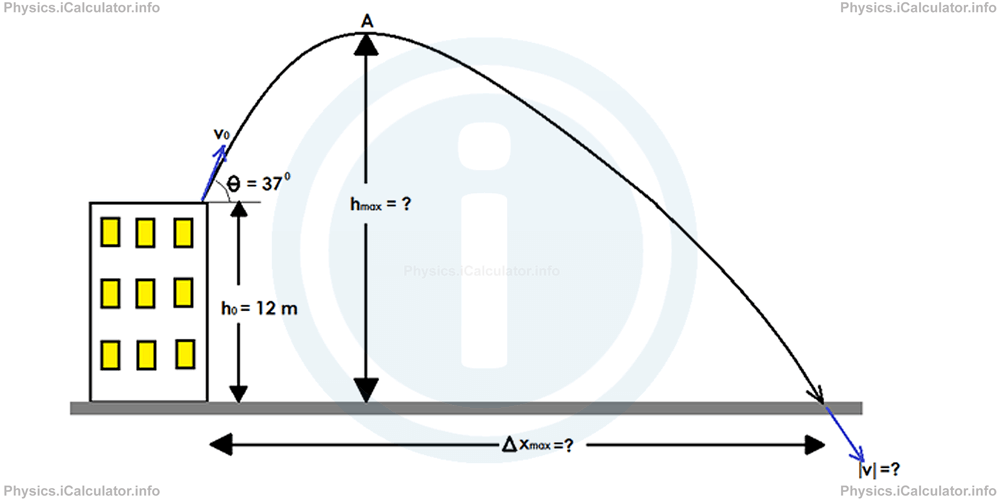
To calculate the maximum height hmax, first we have to calculate the extra height h1 above the building and then add it with the building's height h0. We have:
We know that
v0y = v0 × sin θ = 15 × 0.6 = 9 m/s
vyA = 0
and
Therefore, we obtain after the substitutions:
-81 = -20 × h1
h1 = -81/-20 = 4.05 m
Hence, the maximum height the object can reach is
= 12m + 4.05m
= 16.05m
We can use the equation of projectile
for calculating the total time of flight t. Thus, giving that at the end of motion the position of the object will be y = 0, we obtain after substituting the known values,
-5 × t2 + 9 × t + 12 = 0
5 × t2-9 × t - 12 = 0
We have a quadratic equation (with variable t) which has its constants: A = 5, B = -9, C = -12. Therefore, we have
= (-9)2 - 4 × 5 × (-12)
= 81 + 240
= 321
Therefore, we have
= - (-9) - √321/2 × 5
= 9 - 17.9/10
= -8.9/10
= -0.89 s
This result is negative. But the time cannot be negative, so this value is automatically rejected. The second solution is
= -(-9) + √321/2 × 5
= 9 + 17.9/10
= 26.9/10
= 2.69 s
Hence,
"How many metres away from the building is the ball when it touches the ground?" means: "calculate the total horizontal displacement ∆x⃗ of the object."
Therefore, we have:
= 12 m/s × 2.69 s
= 32.28 m
To calculate the magnitude of the object's final velocity just before touching the ground, we need its components vx and vy. One of them (vx) is already known as vx = v0x = 12 m/s. As for the vertical component of the final velocity vy, we have
In our example ∆y = -12m as at the end of motion, the object is 12 m below the original height. Also, we take g = - 10 m/s2 as initially it was so. Therefore, we obtain after substitutions:
v2y - 81 = 240
v2y = 240 + 81 = 321
vy = √321
= 17.9 m/s
Now, using the equation
we can calculate the magnitude of the final velocity when the object is just touching the ground. Thus,
= √144 + 321
= √465
≈ 21.6 m/s
You have reach the end of Physics lesson 3.12.2 The Physics of Projectile. There are 2 lessons in this physics tutorial covering Motion in Two Dimensions. Projectile Motion, you can access all the lessons from this tutorial below.
More Motion in Two Dimensions. Projectile Motion Lessons and Learning Resources
Whats next?
Enjoy the "The Physics of Projectile" physics lesson? People who liked the "Motion in Two Dimensions. Projectile Motion lesson found the following resources useful:
- Physics Feedback. Helps other - Leave a rating for this physics (see below)
- Kinematics Physics tutorial: Motion in Two Dimensions. Projectile Motion. Read the Motion in Two Dimensions. Projectile Motion physics tutorial and build your physics knowledge of Kinematics
- Kinematics Revision Notes: Motion in Two Dimensions. Projectile Motion. Print the notes so you can revise the key points covered in the physics tutorial for Motion in Two Dimensions. Projectile Motion
- Kinematics Practice Questions: Motion in Two Dimensions. Projectile Motion. Test and improve your knowledge of Motion in Two Dimensions. Projectile Motion with example questins and answers
- Check your calculations for Kinematics questions with our excellent Kinematics calculators which contain full equations and calculations clearly displayed line by line. See the Kinematics Calculators by iCalculator™ below.
- Continuing learning kinematics - read our next physics tutorial: Relative Motion
Help others Learning Physics just like you
Please provide a rating, it takes seconds and helps us to keep this resource free for all to use
We hope you found this Physics lesson "Motion in Two Dimensions. Projectile Motion" useful. If you did it would be great if you could spare the time to rate this physics lesson (simply click on the number of stars that match your assessment of this physics learning aide) and/or share on social media, this helps us identify popular tutorials and calculators and expand our free learning resources to support our users around the world have free access to expand their knowledge of physics and other disciplines.